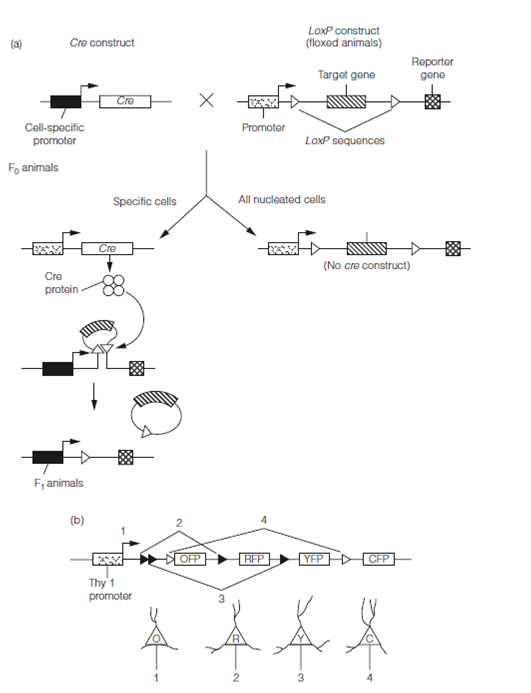Cre/loxP system
The cre/loxP system allows selective gene deletion or activation to be generated by recombination in specific cell types, and at particular times (e.g., stages in development). It requires two types of transgenic animal (usually mice) to be engineered which are sub- sequently crossed.
1. Cre animals are created with a construct that has a gene for a viral recombinase enzyme, cre (causes recombination) downstream of a cell specific promoter. These can be specific for glia (glial fibrillary acidic protein promoter), neurons (e.g., synap- sin 1 or neuron-specific enolase promoters), or even for specific neuron types (e.g., CaMKII promoter is selective for CA1 cells of the hippocampus).
2. Floxed animals are created in which all nucleated cells contain the target gene flanked on both sides by a 34 base pair loxP sequence, derived from bacteriophage P1. (Bacteriophages are viruses that infect bacteria.)
In both cases these animals are genetically engineered by having the construct inserted into a vector (often based on the double stranded circular DNA molecules, plasmids that make up the genome of bacteria). The vector can be engineered with a variety of reporter genes so that its presence can be detected. It can then be injected into the pronucleus of fertilized oocytes or incorporated in embryonic stem cells that are then introduced into blastocysts (early embryos with 8–16 cells). The oocyte or blastocyst is subsequently implanted into a foster mother and the resulting offspring screened to ensure they have incorporated the constructs.
The principle of the cre/loxP system is that the cre enzyme recognizes two loxP sequences if they are in the same 5’–3’ orientation, bringing them together so that recombination effectively excises the target gene between them, leaving behind one loxP site. This hap- pens in the offspring (F1 hybrids) of cre and floxed animal crosses. The floxed constructs are expressed in all nucleated cells in the resulting offspring, but the cre construct is expressed only in the cell type targeted by the promoter. Hence the cre/loxP recombination is cell specific.

Figure: Cre/loxP system. (a) F0 transgenic animals containing cre or floxed gene constructs are crossed. The resulting F1 offspring will express the floxed gene in all of its nucleated cells. In the specific cell type targeted by the cre construct, the expression of cre causes deletion of floxed gene. (b) A floxed construct used for the brainbow technique houses genes for orange (OFP), red (RFP), yellow (YFP), and cyan (CFP) fluorescent proteins. Excisions 1–4 result in neurons fluorescing in orange, red, yellow, and cyan respectively. Other more elaborate constructs allow a huge diversity of color coding of individual cells.
The cre/loxP system can also be used to study the effect of activating a transgene. To achieve this, a floxed construct is produced in which loxP sequences flank a stop codon upstream of the target gene. Now recombination cuts out the stop codon in the cre- expressing cells and the transgene will be transcribed by DNA polymerase. The transgene will remain inactive in all other cells because these do not express cre. Hence the target gene is expressed in a cell-specific way.In the brainbow technique constructs are created with several loxP sites flanking fluorescent protein genes. This allows a variety of excisions to take place resulting in a range of differently color-coded neurons.